Increase Max Bat Whip Or Barrel Speed Creating Hip Shoulder Separation Hitting Torque For Faster Baseball & Softball Swing | When To Load In Little League
Discover how to increase max bat whip or barrel speed creating hip shoulder separation hitting torque for a faster baseball and softball swing. Learn when to load the shoulders in little league with this swing experiment…
Baseball Swing Load: If You Can Bend Sideways You Can Gain 4-MPH Bat Speed
Question: Does a Slight “Downhill” Shoulder Angle Before Landing Boost Baseball Swing Load & Bat Speed?
In this baseball swing load “shoulder” angle experiment using the Zepp (Labs) Baseball app, I wanted to use the Scientific Method to analyze what would happen to Bat & Hand Speed when we took 100 swings with a slight “Downhill” shoulder angle (about 8-10-degrees) versus another 100 swings with level shoulders.
The Feedback Lab parent testimonial about his 14 year old daughter Mia:
“Hey Coach,
It has been way too long but I wanted to share some information that happened yesterday. We are heading up to Chattanooga, Tennessee, the largest showcase in the southeast today. Yesterday was our last day to hit before the showcase and Mia was struggling with her power. We hit about 60-70 balls and Mia was hitting about 10% over the fence (she is usually 40%+). I was looking to make sure she was showing her number, which she was, hiding her hands, which she was, landing with a bent knee, which she was and etc., etc. It was getting late and we had to go and I told Mia she had only 6 balls left. I told her to show me her stance and I noticed that her front shoulder was equal to her back shoulder. I then told her to lower her front shoulder and raise her back one. That was the only change we made to her swing, Mia then hit the next 6 balls over the fence and 2 of them were bombs. I cannot believe the difference this one small change made.
Thanks,
Primo”
SCIENCE-BASED TRAINING:
Improve your hitting strategy dramatically by applying human movement principles.
Learn not only how and what to train but also the science behind the methods.
Background Research
The best resource for getting educated on spinal engine mechanics is to pick up Dr. Serge Gracovetsky’s book The Spinal Engine. For a teased out version of this,
CLICK HERE for a post I did that compared the pitching delivery, hitting, and an overhead tennis serve using this “bending sideways” technique.
Another good book from multiple authors on the subject of spinal engine mechanics, locomotion biomechanics, and springy fascia, check out the book Dynamic Body by leading author Dr. Erik Dalton.
Also, here’s a great Wall Street Journal post about Miggy Cabrera titled, Miguel Cabrera: The Art of Hitting. Check out what the illustration says in the middle of the red circle above…
Hypothesis
Based on the above baseball swing load experiment research and one of the other countless online hitting testimonials I get about “bending sideways” benefits, I think using a slight “Downhill” Shoulder Angle will boost Bat Speed at Impact by at least 3-mph, and Hand Speed Max by 2-mph.
Baseball Swing Load: “Downhill” Shoulder Angle Experiment
Equipment Used:
- Zepp Baseball app
,
- Tanner Tee
,
- Camera Phone
- 33-inch wood bat.
Setup:
- Tyler Doerner, my intern for the summer and a hitter in HPL’s The Feedback Lab, is a redshirt college Freshman. He did the baseball swing load shoulder angle experiment.
- Tyler broke the swing into two steps: 1) get to landing position, pause for 1-2 seconds, 2) then swing, to better control the shoulder angle during the tests.
- So, there was an absence of forward momentum in this experiment.
- The two tests in the experiment were counter-balanced. Which consisted of eight blocks of 25-swings done in the following order ABBA BAAB. “Level Shoulders” were letter ‘A’, and
“Downhill Shoulders” were letter ‘B’. 200 total swings were completed in the experiment, 100 per test. Counter-balancing helps remove the “getting tired” and “not being warmed” up factors.
Data Collected (Zepp Baseball App):
Data Analysis & Conclusion
- There’s a significant 4-mph JUMP in average Bat Speed at Impact with the “Downhill” Shoulder Angle.
- Average Hand Speed Max only increased by 1-mph with the “Downhill” Shoulder Angle.
- There was a small change in Time To Impact, in favor of the “Downhill” Shoulder Angle.
- Not a big change in the Bat Vertical Angle at Impact.
- And there was a significant 3-degree angle change in Attack Angle with “Downhill” Shoulder Angle.
Notes
- We found a slightly bigger increase in average Bat Speed at Impact with the “Downhill” Shoulder Angle compared to my Hypothesis (4-mph versus 3-mph).
- I thought there was going to be a bigger difference in Hand Speed Max, than how it turned out.
- What was surprising was the 3-degree angle change of the attack angle. A 10-degree Attack Angle is a typical line drive. Once you start to get into the 15-20 degree range, you’re looking at more of a home-run launch angle.
- The “Downhill” Shoulder Angle is actually something we’re working in Tyler’s swing. He tends to let go of his angle a little too soon.
- I find that before and after Ball Exit Speed readings with my local hitters who’re familiar with the “Downhill” Shoulder Angle, can increase from 1-3-mph when this it the only mechanic we’re working on.
The Bottom Line?
In this baseball swing load shoulder angle experiment, we can clearly see with the “Downhill” Shoulder Angle that there’s a significant 4-mph jump in Bat Speed at Impact, AND a surprising 3-degree boost in the Attack Angle. The “Downhill” Shoulder Angle is a piece of what I call the Catapult Loading System. The BIG-3 are:
- Downhill shoulder angle,
- Hiding hands from the pitcher, and
- For #3…
- Fix Late Swings Fast: 2025 Pitch Recognition & See-Decide-Swing Training for Youth Baseball Power Hitters - October 6, 2025
- Safe Youth Weighted Bat Training: Proven Overload/Underload Drills to Increase Exit Velocity in Games Starting Tonight - September 29, 2025
- AI Coaching Course 2025: Youth Baseball & Softball Practice Plan + Off-Season & In-Season Workout Builder Fast - September 23, 2025

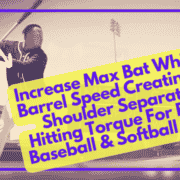



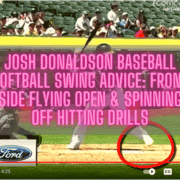
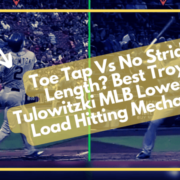

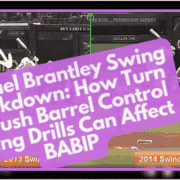
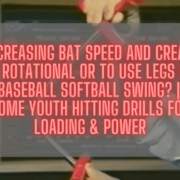


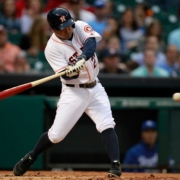



I have always taught that the “load” includes a “down and in” rotation of the front shoulder, basically attaining the position you are talking about. The thing to be careful of with younger hitters is the “equal and opposite reaction” as the swing starts, namely an up and out flying of the front shoulder.
Steve, you’re absolutely correct about the opposite and equal reaction. I tell my hitters to “block” their shoulders from opening too soon…until the last possible second their brain is screaming ‘TURN DAMMIT!’ 😛 lol
Steve,
I agree. The shoulder does go up and away, just don’t do it too soon. We can thanks Sir Isaac Newton and Joey for another great article.
Thanks Joe 😀
Isaac Newton? … Who did he play for?
Buahahahaha
My comment was mostly a low blow to those guys that think you can buck science – or they teach stuff that just doesn’t make sense to the laws of movement and how to produce, utilize, and combat various forces.
Bob,
Sir Isaac Newton played for “The Force.”